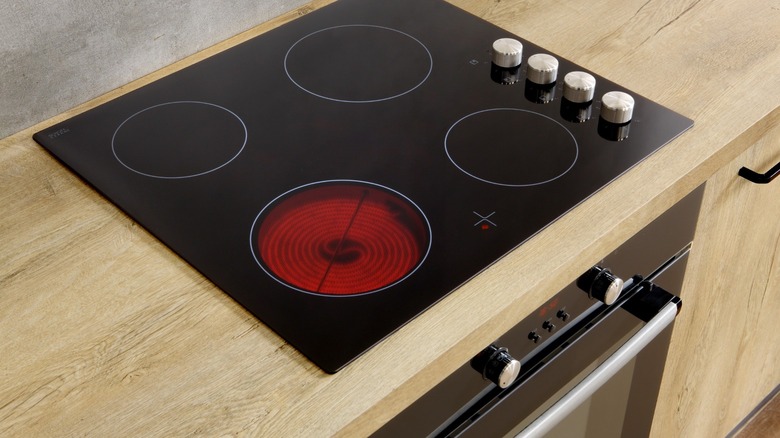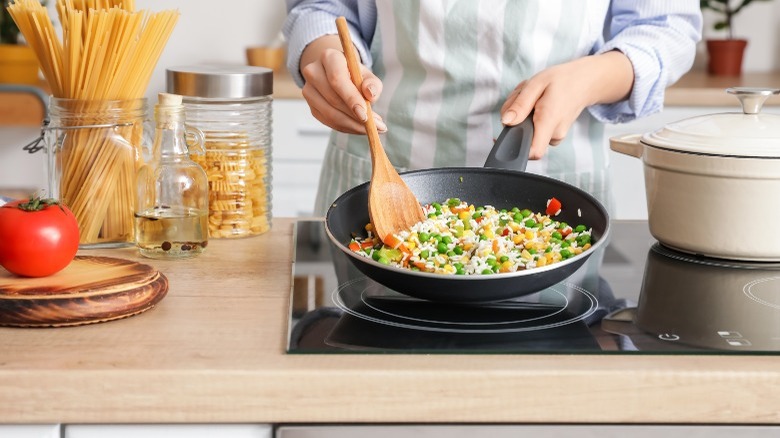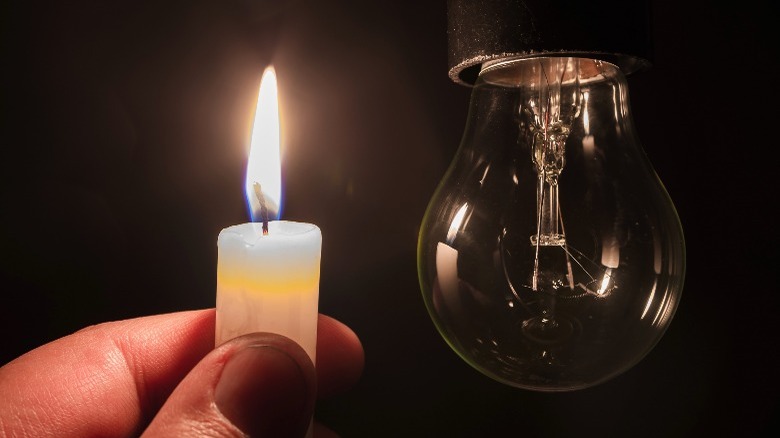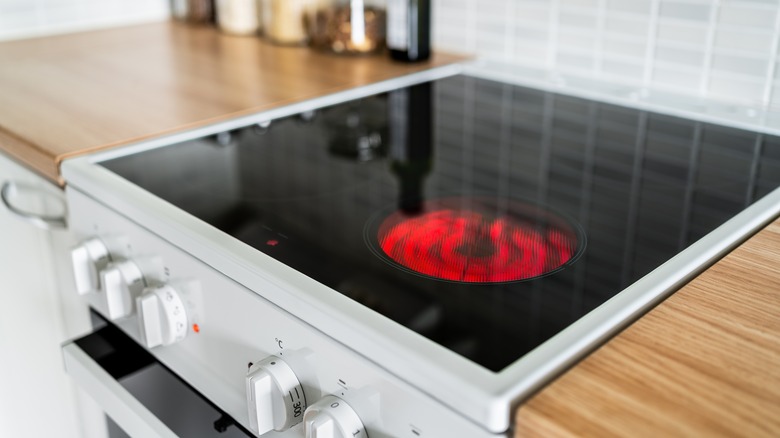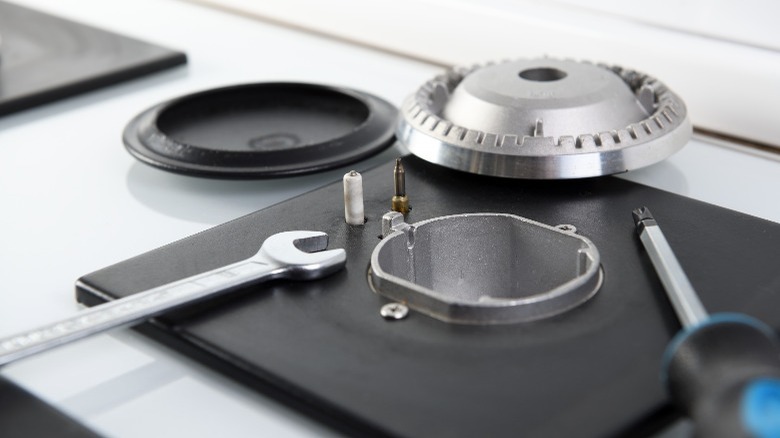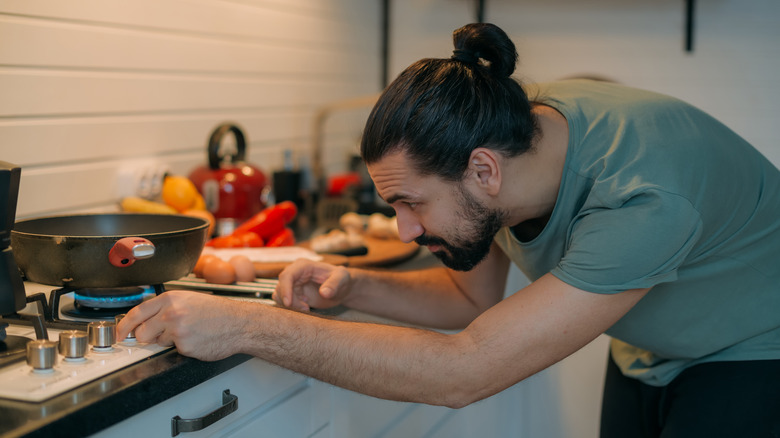The Hidden Downsides Of Electric Stoves
As Heated points out, electric stoves are a cook's worst nightmare, and for multiple reasons. If you're looking into purchasing a new range, there are definitely some hidden downsides of electric stoves. Gas ranges aren't always ideal either, but dual-fuel ovens and double oven ranges are also available, so you can have the best of both worlds (via Appliances Connection). However, these are a bit of an investment, especially when you include installation costs to have both hookups installed. But electric stoves are known for their uneven cooking and can be generally difficult to cook on. They can also be easy to forget to turn off, potentially creating a highly dangerous situation.
But according to Consumer Reports, many Americans use electric stoves, and only about half of homes even have a gas option. And of course, there are terrific models of both available, plus induction heat to consider, along with multiple other factors. So if you're one of the lucky few with both options, it's time to do some research, especially if you're considering going electric. Here's a deep dive into the disadvantages of electric stoves.
Not as energy efficient
According to How To Fix It, using a gas stove costs quite a bit less energy than an electric stove. Although the actual numbers will inevitably vary depending on the energy costs in your area, the difference can be quite significant. In fact, you'll likely pay approximately 36% or more for energy per month, by using an electric stove over a gas stove.
If you do go with an electric stove but would like to save energy costs, there are some helpful habits you can implement (via Spark Energy). Use a flat-bottomed pan that sits flush on the cooktop to make heating more efficient. You'll also want to use cookware as close in size to the diameter of your burners as possible to avoid wasting heat. You can also do a little prep work and defrost food prior to cooking to cut down on the actual heating time needed.
Doesn't cook as well
When comparing cooking with electric or gas, like anything else, you get both opinions. However, as Reviewed points out, most pros prefer gas on the cooktop. One big perk is that gas burners heat up instantly. They like the fact that the level of heat is completely controllable and customizable. Plus, these pros can pinpoint just the right temperature with gas burners, a benefit to home chefs as well. Chef Bruce Mattel, a dean at the Culinary Institute of America points out, "Gas tends to have many settings because you can turn the control knobs in tiny increments. With electric, there's usually a limited number of settings."
When making complicated or complex dishes like caramel or steaming rice, you might need to lower the temperature of the burner quickly for the best results. Unfortunately, electric burners don't cool down very fast either (via Tasting Table). The only way to expedite transitioning between temperatures is to use two burners at the same time. One must be at the highest setting and the other preheated at the cooler temperature. Once your pan is ready for the lower heat, you can move it from the hotter burner to the lower one.
Power outages are a problem
If you live in an area where there are a lot of storms and power outages, having an electric stove can be problematic, to say the least. According to Amana, a lack of power error can be triggered by a power outage, requiring you to reset the breaker afterward. This is in addition to the fact that during the time the power is out, an electric stove won't work. Other problems with power can cause an electric stove not to work (via Appliance Repair Specialists). It takes 240 volts, traveling between two legs of current for electric ranges to operate. If one leg is interrupted by a blown fuse or the electrical source isn't providing enough power, the unit won't work. Additionally, the power supply wires can burn out or the thermal fuse can blow. These failed parts of these would need to be replaced for the oven to function.
As P.C. Richard & Son points out, a gas stovetop might be able to be lit manually in the event of a power outage. Turn on the gas and use a long match to ignite the flame. Then, you should be able to adjust the flame while cooking and simply turn off the gas when you're done. However, some models feature a safety mechanism to prevent gas leaks. This interlock blocks the gas flow when there's no power running to the stove. So, these gas cooktops can't be lit in the event of an outage.
Electric stoves can explode
People typically think of open-flame gas stoves as being a danger, there are some specific reasons your electric stove can explode, as well (via Perfect Stove). If you've ever cooked on exposed electric burners, you know that sometimes, the coils on the burners move around and get out of position. Additionally, they can become damaged over time. The coils on the burners can throw sparks when the coil range element becomes loose or damaged or comes out of position. Additionally, you don't want to get the coils too hot for an extended period of time when you aren't using them, or you risk an explosion.
But the really scary statistics come from the National Fire Protection Association, where they report that during the years 2014-2018, cooking was the leading cause of home fires. Of these, 61% involved ranges or cooktops. Many of these fires were the result of unattended cooking or oil and grease. What might shock many, is that those who use electric stoves were found to be at a greater fire risk than gas range users.
Can break down or shut off
Electric stoves are known to develop some common problems (via Universal Appliance Repair). Some common issues people have with electric stove cooktops are things like trouble with the coils not heating up. When you remove the coils to clean your stove's burners, it's important that they be reconnected correctly, or they won't work. If they fail, it could also be the internal ignition switch, which is best left to the professionals. Another common issue is the ability to adjust the temperature on your burners, where regardless of the settings you choose, the burner only heats to one temperature. This is a problem typically seen when an electric stove's infinite switch is faulty.
Electric ovens can also be problematic as well. This is typically due to a few common problems that can occur (via Mid America Service Appliance Repair). Sometimes the temperature sensor can be broken inside the oven, causing it to heat unevenly. When this happens, heat isn't regulated inside the oven during cooking, and doesn't remain constant. Electric ovens also feature a baking element that can burn out. When this part fails, it leaves the broil element at the top of the oven as the only source of heat for the unit. The oven will fail to cook properly until this baking element is professionally replaced.
According to Appliance Analysts, electric stoves can also have issues with the unit shutting off on its own even without a broken part. Many electric stoves have safety features that shut them off when they are on for an extended period of time. This safeguard can become an inconvenience if you're whipping up a recipe with a long time frame or cooking a big holiday meal.
Takes longer to heat up and cool down
We've all had experiences with electric stove burners, as well as electric ovens, that seem to take forever to heat up. According to Eco Family Life, this problem is caused mostly because of the way that electric stoves heat. Electric stovetops must first heat the coil of the burner and then transfer that heat through the ceramic or glass top covering. Gas stoves immediately apply heat directly to the cookware. As Kitchensnitches points out, there's another reason this happens, and it has to do with wattage. Gas burners offer a robust 10,000 watts of energy, while electric burners are only about 1,000 watts. In addition, gas burners heat all around the bottom and even up the sides of the cookware. Electric burners only heat from the bottom of the pan at the points where it contacts the stove's surface.
One trick for fast cooking is to allow your electric burner to preheat for at least 15 minutes before placing your pan on it. You can also preheat oven-safe dishes in the oven at 250 degrees while you wait for the burner to heat up. However, both of these tedious tasks are avoidable by opting for gas burners that heat up instantly.
Can be dangerous for seniors
We've already discussed multiple downsides to electric stoves, but there's one more important one. According to Graying With Grace, cooking is the number one cause of injury to seniors. As a person gets older, they can become forgetful. As previously mentioned, electric stoves in particular are easy to forget to turn off because they don't have a flame like a gas stove.
Induction stovetop burners can be a better option for seniors that want to safely use a cooktop. These burners only work with specific cookware and because they use a magnetic form of energy to heat, the burners themselves don't even get hot to the touch. Also, if left unattended they don't cause damage or incidental fires.
Unfortunately, cooking is the third leading cause of fire deaths in seniors. Those who own electric stoves are advised to install a stove shut-off device like FireAvert. This is a device that automatically shuts off the stove as soon as the fire alarm is triggered. Having a fire extinguisher and a fire blanket in the kitchen can be a lifesaver, regardless of whether you have a gas or an electric stove. Seniors should also be mindful to set timers while cooking to avoid forgetting about burners being on.
